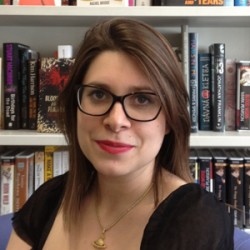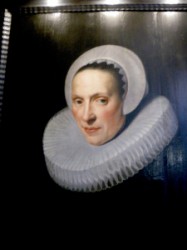Richard Lee talks to Jessie Burton, star debut author at the London Book Fair
Richard Lee
Jessie Burton’s The Miniaturist, ‘a feminist golden-age fiction’, tells the story of 18 year-old Nella, newly married to wealthy merchant Johannes – who sends her an exact miniature replica of their home as a wedding gift. Unnerving in its precise attention to detail, Nella begins to fear for every member of the household as escalating real-life dramas are mirrored in miniature form.
RL: How many countries is it that the book has sold to?
JB: I think 16, with other auctions ongoing as we speak. I am currently packing my suitcase to Brazil, and then Juliet and I are going to live in a tea-house on the outskirts of Tokyo.
RL: Obviously a good choice, but how did you choose your agent?
JB: I began following Juliet on Twitter last year, and was always impressed by her mixture of professional advice and humour. She knows how to use her Twitter! Every Sunday she does an #askagent and her answers, her energy and expertise were very apparent. Then I read an online interview with her which was dated my 30th birthday, and she was reading a reference book on the Dutch Golden Age which I too had been poring over. She said she was looking for literary historical fiction, and I was looking for someone who was talented, approachable, inventive and dedicated. Juliet is all these things and more. I sent her the first three chapters and a covering letter, and soon she asked for the full MS. We met, we clicked, and this past fortnight has confirmed to me what I suspected already – that I made the best decision of my fledgling professional life.
RL: In what ways did the Curtis Brown Writing course (or any other) help you?
JB: The course was a bit of a turning point for me. I found it a bit squeamish to call myself a writer when I hadn’t published anything. I’d been in the hinterland of creativity for a while, temping as a PA in the City a lot, doing acting gigs whenever the hand of fate decided that would be, and writing under cover, and suddenly I was in a room with people who loved reading, writing, talking about books…it was wonderful. I never thought I’d get a place, but that sliver of affirmation gave me a moment to think that maybe, maybe, this could happen for me.
I loved the sessions where we talked over people’s extracts from their novels, I loved the opportunity to hear publishing advice from the horse’s mouth. The course never told us how to write – but just like a music school, a dance school or an art school, it focused the creative mind on the myriad methods available, a tool box if you like. It also made me realise that writing is a process of trial and error, and that was OK. It taught me about the publishing industry, of which I knew nothing. It taught me to be robust and to manage my expectations.
RL: At what stage did you know this novel was working for you? (Have you started and not finished other novels?)
JB: In 2008, I did start 80,000 words of a novel set in London in 1796, and I might go back to it one day. But this one, The Miniaturist – well, it just had so much fuel in it, that even when it was difficult (which it was), I just didn’t mind carrying on, staring into the void, because I knew one of these characters, or one of my thematic explorations, would come good again. This might sound contradictory, but though I wrote the book chronologically, the writing process never felt that it was going in a neat and linear way. I had early, impressionistic scenes in my head, and sometimes getting the novel out of me was like blood from a stone – finding the plot a sprawl, a character not enough, or I was over-writing and making things too complicated – and other times I really flew, I could see that character standing in front of me, they began speaking before I put the words in their mouth. Or I could sense a moment when something terrible for the characters was about to happen, and the scene just unravelled on my screen or on the page. Most of the time it was just graft, crossing out, then more graft.
My historical research was deep and I always went back to it whenever I was stuck. A 1671 recipe book, a Burgomaster’s portrait, a poem etched in a Dutchman’s prayerbook, how cold the temperature is in the Amsterdam Old Church at a certain time of day – and of course Petronella’s doll house – all were so helpful as triggers to get back to what I wanted to say. I think in the last part of 2012 there was a bit of an acceleration and things just truly slotted into place after many, many workings out. It just took me so much longer than I thought! Lesson learned. Some things were there from the beginning, like the opening for example – but other scenes and characters were sculpted over and over again, and there were several judicious carvings. It was like a game of dominoes – I moved one thing, it all fell over and had to be rearranged. Or making a pizza dough on the palm of your hand – you put on all the toppings, but one side starts to droop – you pick that side up, the other side goes, and so on. Until eventually everything is balanced and all you can do is stick it in the oven and cross your fingers.
RL: You said you were looking for strong female characters – is that what drew you to the past, to domestic restraint to try your character?
JB: I’d like to define what I mean by ‘strong’ female characters, which will help me answer the second part of your question. It’s 2013, and yet so often I read a book or see something on the news, or TV, or film, and the females are defined by what the men in their life are doing, or their very beings pivot precariously on the artificial constructs of femininity. Or their dilemmas are particular only to womankind within their social sphere, not humankind. Often the male narrative is universal but women suffer these oddly prevalent avatars who have IQs of 200 and look like Angelina Jolie. I have yet to meet such a person in real life. So many unattainable extremes! Where are the normal, generous women who consider themselves just, well, human?
I am a feminist, and I know sexist ideals are internalised everywhere for both men and women. And although we need to keep on addressing oppression and prejudice pertinent to women across the world, in my book I wanted to create women who are not more ‘strongly female’ or ‘stronger than other females’, or ‘strong’ because they are braver than men, or can physically lift more saucepans or anything like that. I just wanted some women who for once are not defined by any other ideal than that they are human.
They may seem ‘strong’ – but that is because most of women’s generalised (and here I emphasise the word generalised!) heritage is presented in pastel shades, with the occasional streak of red rising up from history, simultaneously admired and shamed. All I wanted was varied, quixotic characters with many sides – they have goodness, malice, kindness, intelligence and stupidity – just like males in fiction and the media have as a given. Their gender-specific problems in the book (marriage, motherhood, lack of spending power and agency) do not define them in the way they interact with one another, or the way they view themselves – I can’t find a better analogy in my head right now other than that a terrier will take on a mastiff. I wasn’t drawn to a historic setting in order to set up the issue of a rounder female character, but it does help. You lock a person up, you keep them in the home, and you are going to have some interesting rebellions. They are going to look for their power in whatever way they can.
RL: How did you research 1686 Amsterdam? It is based on an artifact belonging to Petronella Oortman, but is your Petronella a documented Petronella or mostly fictitious?
JB: I have a bibliography as long as my arm. And then there are first-hand resources -maps, paintings, diaries, prices of food, inventories, wills – and the physical city of Amsterdam itself. I first went in 2009, which is when I saw the house in the Rijksmuseum, and then again August 2012 for my birthday – with a long list of questions and locations to visit post-fourth draft. Where did they bury the bodies in the Old Church? How many windows on the front of a gable? How did they winch furniture in? A lot in the book is all historically true in terms of life in the city, and then a lot of it – because it is a novel! – is pure invention.
‘My’ Petronella is known as Nella. Only one other character pointedly calls her Petronella throughout the book. The ‘real’ Petronella was twice-widowed and lived with her silk merchant husband Johannes on the Warmoestraat. I have upgraded them (I hope they’re grateful) to one of the most exclusive addresses on the Golden Bend on Amsterdam’s Heren canal. The only thing they have in common is their name and the impetus to build a doll house that became known as a wonder of the world. I have made my Nella much younger than her husband, for reasons which will become apparent, and invented every other character in the book. It took the real Petronella nineteen years to furnish her house, but my Nella gets going on it a bit quicker, you’ll be pleased to hear.
RL: I loved your piece on Hilary Mantel. Who else influences your work?
JB: Thank you! I think Hilary Mantel is so extraordinary. Other influences are most definitely Margaret Atwood – although whenever I reread one of her novels or essays I sort of wonder why I bother! Her wit, her sharpness, her poeticism, is unrivalled. The writing of Siri Hustvedt, Penelope Lively and Carol Ann Duffy has definitely influenced me as well. Edward Thomas for some of the most beautiful, questing restlessness in the English language. Claire Tomalin for revelatory and assiduous biography. Alice Munro for the taste barometer. Never too much of this, never too much of that. She’s a cool glass of water, and then she sticks in the knife.
RL: Is your next book historical? Can you tell us anything about it??
JB: Again, it’s those early impressionistic scenes! Although I am loathe to leave Amsterdam, I think I may be going over to Spain in the 1930s and Oxford in the 1960s – with a dangerous plunge into Vienna. A mother who wasn’t who she said she was, a woman’s eye view of 20th century, emancipation, disappointment, passion and self-knowledge. That’s all I know at the moment!
Read more about Jessie in the Guardian, The Bookseller, and at Curtis Brown Creative. Read about what Juliet Mushens looks for in a book on Jennifer Williams’ blog.











